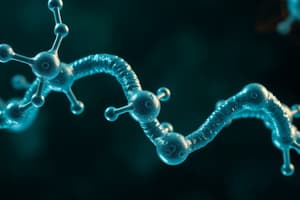Podcast
Questions and Answers
What is the primary structure of the cell membrane?
What is the primary structure of the cell membrane?
The primary structure of the cell membrane is the phospholipid bilayer.
What model describes the fluid and dynamic nature of the cell membrane?
What model describes the fluid and dynamic nature of the cell membrane?
The model that describes the cell membrane's fluid and dynamic nature is the Fluid-Mosaic Model.
What are lipid rafts and how do they differ from the surrounding membrane?
What are lipid rafts and how do they differ from the surrounding membrane?
Lipid rafts are regions of the plasma membrane that are more rigid due to tightly packed fatty acid chains and a higher concentration of cholesterol and glycosphingolipids.
What roles do lipid rafts play in cellular functions?
What roles do lipid rafts play in cellular functions?
What are caveolae and how do they affect the cell membrane?
What are caveolae and how do they affect the cell membrane?
How does the fluidity of the cell membrane contribute to its function?
How does the fluidity of the cell membrane contribute to its function?
Why is the cell membrane described as a mosaic?
Why is the cell membrane described as a mosaic?
In what ways do cholesterol molecules influence the plasma membrane?
In what ways do cholesterol molecules influence the plasma membrane?
What impact does the packing of phospholipid fatty acid chains have on the membrane properties?
What impact does the packing of phospholipid fatty acid chains have on the membrane properties?
How do the structural components of the cell membrane assist in signal transduction?
How do the structural components of the cell membrane assist in signal transduction?
Flashcards are hidden until you start studying
Study Notes
Biological Membranes Overview
- Membranes serve as a selective barrier for individual cells and organelles (e.g., nuclear envelope, mitochondrial membrane).
- Cell membrane facilitates controlled transport of molecules, with specific receptors for substances like hormones.
- Mitochondrial membranes also function in energy production.
Composition of Biological Membranes
- Lipids: Most abundant macromolecules; form the main structure of membranes, including phospholipids, cholesterol, and glycolipids.
- Proteins: Essential for biological functions; enable transport and serve as receptors.
- Carbohydrates: Present as glycoproteins and glycolipids, located externally on cell membranes.
Membrane Lipid Characteristics
- Phospholipids: Composed of hydrophilic heads (phosphate groups) and hydrophobic tails (hydrocarbon chains), arranged in bilayer formation in aqueous solutions.
- Cholesterol: Intercalates between phospholipids, enhancing membrane stability and fluidity.
- Glycolipids: Have carbohydrate portions facing outward, playing roles in cell recognition and signaling, including blood group antigens.
Membrane Protein Types
- Integral Proteins: Include transmembrane and lipid-anchored proteins; essential for communication and transport across the membrane.
- Peripheral Proteins: Located on the cytosolic side, indirectly attached to lipids, involved in maintaining cell shape and signaling.
Functions of Membrane Proteins
- Integral Proteins: Act as receptors, ion channels, and transport proteins facilitating the movement of molecules.
- Peripheral Proteins: Include cytoskeletal proteins for structural stability and enzymes for signaling processes.
Membrane Carbohydrates
- Glycolipids and Glycoproteins: Involved in cell-to-cell interactions; glycophorin exemplifies an integral glycoprotein vital for blood group recognition and fertilization.
Key Characteristics of Cell Membranes
- Bilayer Arrangement: Two lipid leaflets with polar groups facing aqueous environments and nonpolar tails oriented inward.
- Fluidity: Lipid movement depends on the saturation of fatty acids; allows lateral, rotational, and some transverse movements, contributing to membrane dynamics.
- Stability: Cholesterol molecules provide stability and support despite overall fluidity.
- Asymmetry: Distinct functions and orientations for outer and inner membrane leaflets due to unequal distribution of components.
- Fluid Mosaic Model: Describes the dynamic nature of membrane components that can move laterally, presenting a mosaic of different structures.
- Lipid Rafts: Specialized regions enriched with cholesterol and glycosphingolipids; confer rigidity and play roles in transport, endocytosis, and signal transduction.
Other Important Terms
- Caveolae: Flask-shaped invaginations of the membrane associated with caveolin proteins; involved in signaling and altering membrane morphology.
Studying That Suits You
Use AI to generate personalized quizzes and flashcards to suit your learning preferences.




